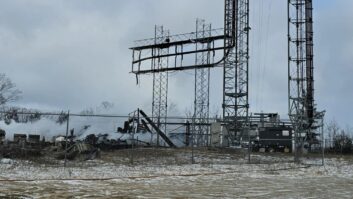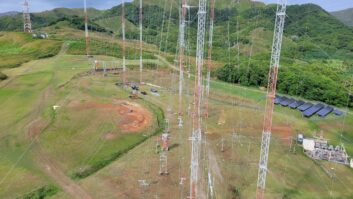(click thumbnail)
833A Tubes.

Many people think old AM transmitters are worthless.
If a high-level, plate-modulated tube transmitter is replaced by a shiny new solid-state transmitter, why should the old one be kept? Heck, you might get $500 for the relic.
Well, I am here to tell you that the new whiz-bang transmitter should be backed up by something that runs when trouble strikes.
One station owner told me the worst management decision he ever made was to get rid of his old transmitter after the new one arrived. He paid for that decision by being off the air for three days.
Solid-state transmitters need to see a 50-ohm load with little reactance in order to run properly. Old tube transmitters can run into a “coat hanger,” as many veteran engineers would say. If the AM antenna is misbehaving, a tube transmitter can be your savior while antenna repairs are made.
Most transmitters sold today are touted as being very reliable because a power amplifier module can fail and the transmitter will stay on the air at reduced power. That is fine until there is a logic problem, a power supply problem, a driver problem, an output network problem or some other show-stopper.

100% Modulation. Tubes with good emission give low-distortion results.
Having grown up in a tube transmitter era, I really appreciate the simplicity of transmitters from the 1960s. Probably the best example in my mind is the Gates, now Harris, BC-1G. It is a 1,000-watt transmitter using 833A tubes that really do glow in the dark. One of my clients bought two of these for use as backups for his newly purchased solid-state transmitters at two new AM stations he constructed in recent years.
Warning! If you decide to take on a project like this, and if the transmitter you are going to work on has PCB-filled capacitors or PCB-filled transformers, you really want to replace them before turning the power on. The same goes for mercury vapor rectifier tubes. Anything else in an old transmitter is harmless except for the 2,500 or more volts when the high voltage is turned on.
Sweat-reduction factor
The first part of a transmitter rebuild project is to test the transmitter and make repairs necessary to get it running to factory specifications on the original frequency into a dummy load. Be sure to spend some time cleaning and replace any questionable components that you can spot with your eyes.

125% Modulation. The audio is turned up another 2 dB.
Most transmitters from the 1950s through the 1970s came with a tuning chart in the instruction book. Capacitors values are listed for every frequency on the dial. Also shown is the number of turns necessary on each of the tuning coils for each frequency, or group of frequencies.
If your project involves changing frequency, you will need a crystal for the RF oscillator. Back then, they were known as “fundamental” crystals that oscillated at the frequency at which the transmitter was intended to run. Later transmitters used less expensive crystals that were two or four times the operating frequency of the transmitter. That higher frequency was divided down to the final operating frequency. Fundamental crystals are available from International Crystal www.icmfg.com for operation at 1 MHz and above, or from JAN crystal www.jancrystals.com for any channel on the AM band. You might even find what you want at commercialradiocompany.us.
I start a tune-up at the crystal oscillator before turning on the high voltage at the lowest transmitter power setting. Once things look right at low power, I go to high power and really make it sing.
(click thumbnail)
Bauer 707.

On AM transmitters, there is more to making them run than getting power at carrier. I use an oscilloscope on an RF sample port at the output of the transmitter to watch the modulated envelope when an audio oscillator at 1 kHz is connected to the audio input of the transmitter.
Tubes with good emission give low-distortion results as shown on the “100 percent modulated photo.” Running regular programming audio tells me almost nothing about the audio performance of a transmitter. Another photo shows the audio turned up an additional 2 dB. You see the carrier go down to zero for an extended period of time and the positive peaks go up with the additional audio. That is +125 percent positive modulation.
If the transmitter design is less-than-great or the tubes are a bit low on emission, you might have to be satisfied with 100 percent positive modulation. I write this assuming the transmitter will be used on the air only in emergencies.
Best to run the old transmitter at least once every three months. You will really appreciate the value of a backup transmitter the first time you use it on the air. Sure, it is not as energy efficient, but it will reduce the sweat on your brow by a factor of 100 when it is in on the air.
Mark Persons, WØMH, is certified by the Society of Broadcast Engineers as a Professional Broadcast Engineer and has more than 30 years experience. His website is www.mwpersons.com.











